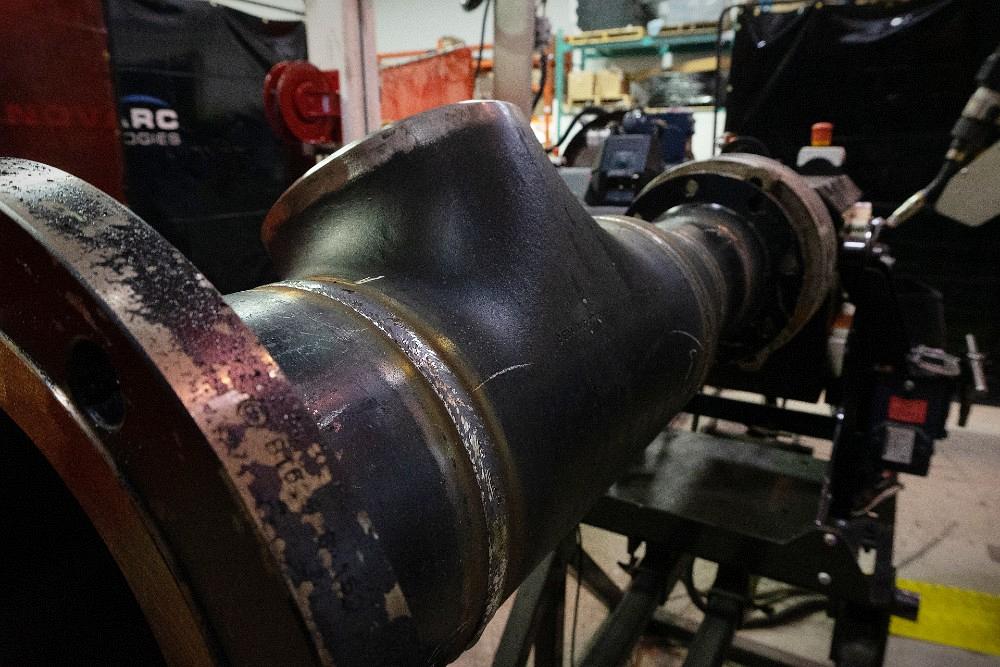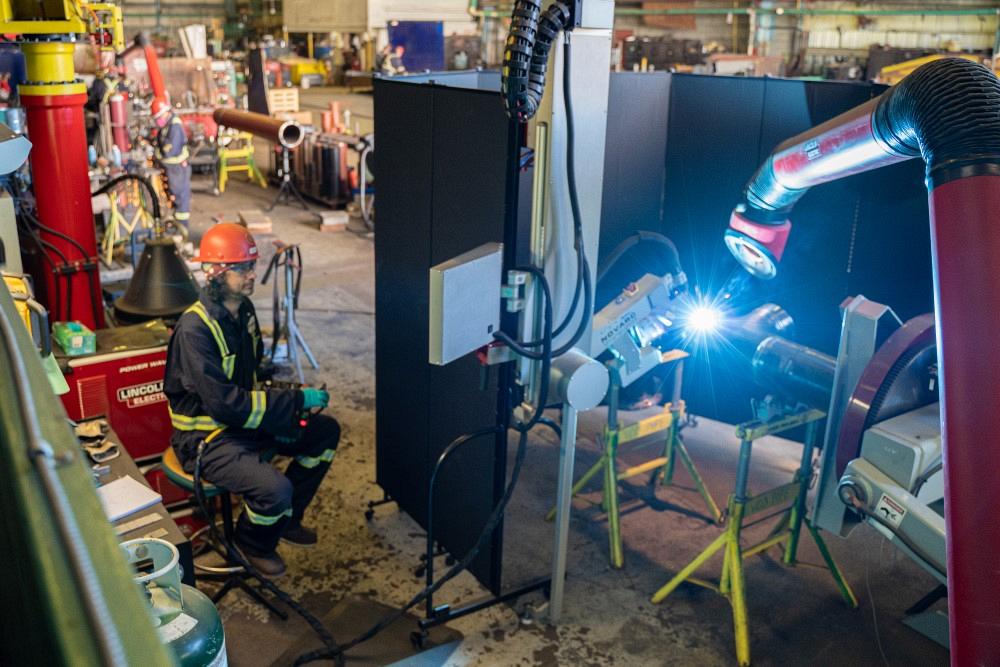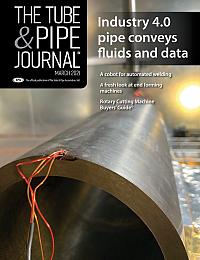Director of Marketing
- FMA
- The Fabricator
- FABTECH
- Canadian Metalworking
Categories
- Additive Manufacturing
- Aluminum Welding
- Arc Welding
- Assembly and Joining
- Automation and Robotics
- Bending and Forming
- Consumables
- Cutting and Weld Prep
- Electric Vehicles
- En Español
- Finishing
- Hydroforming
- Laser Cutting
- Laser Welding
- Machining
- Manufacturing Software
- Materials Handling
- Metals/Materials
- Oxyfuel Cutting
- Plasma Cutting
- Power Tools
- Punching and Other Holemaking
- Roll Forming
- Safety
- Sawing
- Shearing
- Shop Management
- Testing and Measuring
- Tube and Pipe Fabrication
- Tube and Pipe Production
- Waterjet Cutting
Industry Directory
Webcasts
Podcasts
FAB 40
Advertise
Subscribe
Account Login
Search
Specialty cobot handles pipe spool welding
Cobots designed for welds can make it easier while the operator assists
- By Melissa Bayanzadeh
- March 10, 2021
- Article
- Tube and Pipe Fabrication

Designed for semiautomatic welding in the 1G position, the SWR improves the ergonomics of pipe welding by having the robot take on the heavy lifting and providing a consistent weave motion. Images: Novarc
As the world struggles through the COVID-19 pandemic, robots are becoming accepted more readily in the workplace, especially for activities that normally require human contact. Robots continue to promise significantly improved productivity and performance for many tasks, and they have a role in assisting less-experienced labor.
Formerly the domain of low-mix, high-volume applications, robots these days also are useful for high-mix, low-volume applications. Their flexibility has grown exponentially, and prices have fallen dramatically over the decades, putting them within financial reach of small fabrication shops.
The early introduction of robots was basically a process of applying off-the-shelf systems that had little in the way of customization. As time went on, advances in control technology facilitated more customized solutions. As with any other capital investment, the challenge is knowing what the organization needs and justifying the capital investment relative to the potential benefits.
In addition to performing work with great accuracy and consistency, the potential speed of a robot leads to questions of work flow disruption. Will upstream systems keep up? Can downstream systems do the same? Beyond training, other personnel questions are critical. Will the staff commit fully to automation, accepting the system as an evolution in shop culture?
The number of robots used worldwide has tripled in the past 20 years and has now reached 2.25 million. That number is predicted to grow to 20 million by 2030. In industries experiencing severe labor shortages, the robotic revolution offers tremendous relief. The welding industry, for example, is facing a shortage of skilled welders, as many are retiring and not enough young laborers are entering the profession. And then there’s the competitive nature of fabrication shops serving the manufacturing industry.
Many have realized the benefits of investing in robotics and flexible automation to increase their competitiveness, improve their bid rate on projects, and increase margins on existing projects. But how do industries such as contract manufacturing, oil and gas, and shipbuilding make the leap from experienced, human welders to automation on the production line?
Introducing the Welding Cobot
As the name implies, a collaborative robot, or cobot, is designed to work with workers rather than replace them. Enabled with artificial intelligence augmented with a very detailed understanding of the application, a cobot’s capabilities are vast. A cobot can help less-experienced workers do the tasks that only more senior, highly skilled workers would be expected to perform. At the same time, collaborative robots help shops achieve leaps in productivity as the robot builds on its intelligence through machine-based learning while working alongside people to make their tasks less strenuous, more consistent, and safer.
Although cobots and robots have some fundamental differences, they have much in common, including the ability to work with rock-solid consistency.
Industrial robots, deployed since the early 1970s, initially were used for doing dull, dirty, and repetitive tasks often considered dangerous for humans. Today, the welding industry is using cobots to increase productivity while improving weld quality through enhanced technology such as artificial intelligence. As a result, cobots have evolved to be more efficient and more proficient than robots.
One cobot user in Canada, Seaspan Shipyards, a provider of shipbuilding and repair, was looking to find a technology that offered both productivity and quality improvements in pipe fabrication for a water treatment system. The project would involve welding and installing on ships a variety of pipe spools, about 85 in all. The company invested in a collaborative Spool Welding Robot (SWR) from Novarc and, as a result, welders at its Vancouver Drydock are able to generate pipe joints in about 40 minutes, a job that used to take four and a half hours. By implementing a cobot, Vancouver Drydock was able to increase its productivity by more than 400% and achieve consistent X-ray quality welds 100% of the time.
A Specialized Robot for a Specialized Task
The SWR uses the power and precision of robotics and the learning capability of artificial intelligence to improve the welding process. It’s a semiautomated welding process, as the machine works alongside a person.As a cobot, it has a safety system that limits its motions to safe speeds and safe amounts of torque. If anyone, or anything, should bump the SWR while it’s in operation, it immediately ceases all operations. The cobot is designed to meet all the safety requirements of ISO/TS 15066, which eliminates the need for fencing or a safety cell. A junior welder can stand beside the cobot and make changes as the weld progresses.

A welding cobot combines the best of two worlds: the accuracy and consistency of a mechanized system and the judgment of an operator.
The operator stands nearby, observing the human-machine interface as the weld progresses in real time, and uses the pendant control to make slight adjustments when necessary. The system assists the operator in seam tracking, so the operator’s primary focus is the weld. The operator’s role concerns the usual weld factors that can vary from weld to weld, such as fit-up, the amount of arc light, and spatter, intervening only when necessary to assist.
Intended to run continuously, the cobot doesn’t come to a stop throughout the operation from the root to the cap pass.
Capable of a radial reach of 15 ft. and a linear reach of 30 ft., the unit’s footprint is relatively small, just 4 ft. by 4 ft. It handles pipe from 2 to 60 in. dia.with appropriate pipe positioners. It uses a built-in laser scanner, a point laser, and a closed-loop control system to maintain the torch-to-pipe distance with an accuracy of +/- 0.004 in.
Traceability is a large concern in many industries and a growing concern in others, and this system facilitates these efforts by recording every weld in real time. It provides an enhanced view of the groove and puddle, a recording of the weld in real time with key weld parameters embedded on the screen, and improved weld quality by analyzing recorded videos in parallel with the weld parameters. These weld parameters are saved by NovData, the company’s monitoring software, which automatically creates in-depth production reports of each weld.
About the Author
Melissa Bayanzadeh
1225 Keith Road E. Unit 6
North Vancouver, V7J 1J3 Canada
604-428-0050
About the Publication
subscribe now

The Tube and Pipe Journal became the first magazine dedicated to serving the metal tube and pipe industry in 1990. Today, it remains the only North American publication devoted to this industry, and it has become the most trusted source of information for tube and pipe professionals.
start your free subscription- Stay connected from anywhere

Easily access valuable industry resources now with full access to the digital edition of The Fabricator.

Easily access valuable industry resources now with full access to the digital edition of The Welder.

Easily access valuable industry resources now with full access to the digital edition of The Tube and Pipe Journal.
- Podcasting
- Podcast:
- The Fabricator Podcast
- Published:
- 04/16/2024
- Running Time:
- 63:29
In this episode of The Fabricator Podcast, Caleb Chamberlain, co-founder and CEO of OSH Cut, discusses his company’s...
- Trending Articles
Zekelman Industries to invest $120 million in Arkansas expansion

3D laser tube cutting system available in 3, 4, or 5 kW

Corrosion-inhibiting coating can be peeled off after use

Brushless copper tubing cutter adjusts to ODs up to 2-1/8 in.

HGG Profiling Equipment names area sales manager

- Industry Events
16th Annual Safety Conference
- April 30 - May 1, 2024
- Elgin,
Pipe and Tube Conference
- May 21 - 22, 2024
- Omaha, NE
World-Class Roll Forming Workshop
- June 5 - 6, 2024
- Louisville, KY
Advanced Laser Application Workshop
- June 25 - 27, 2024
- Novi, MI


























